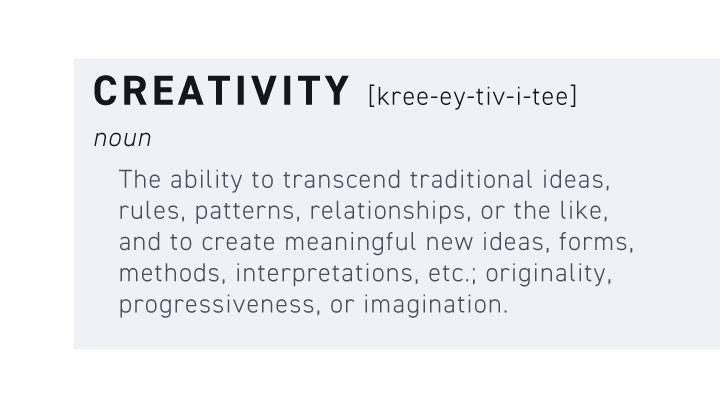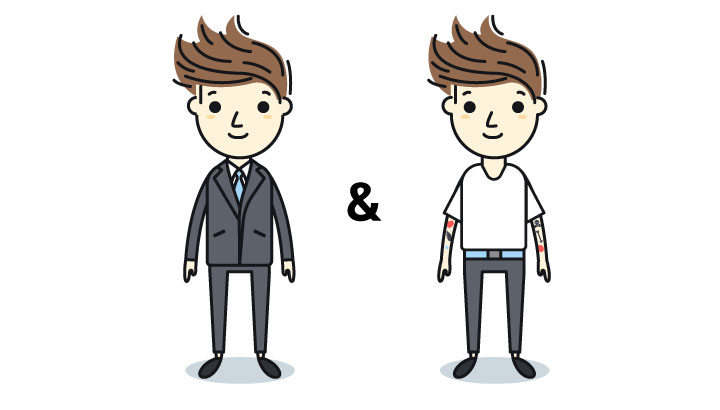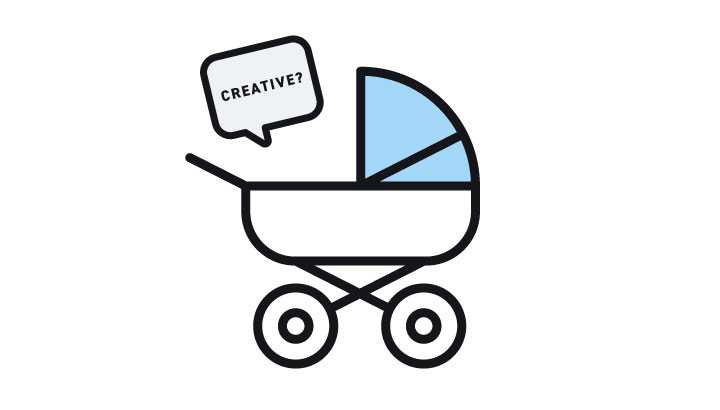November 24 is national Celebrate Your Unique Talent Day. Like Thanksgiving, it’s a time to appreciate all of the people around you and their unique talents. But November is far from the only time to celebrate your unique, creative abilities.
We thought it would be a good time to understand and appreciate our unique creative talents. Does everyone have a unique creative talent? How do we recognize it if we have it? And are people born creative or is it a skill we can learn?
Before we dig into that pile of mashed potatoes, let’s dig into the idea of creativity and how it impacts your life.
What the Heck Is Creativity?

“Of all human activities, creativity comes closest to providing the fulfillment we all hope to get in our lives. Call it full-blast living.”
When you think about creativity, you probably imagine a painter—Picasso or Rembrandt or your weird Aunt Martha who only paints on burlap and whose house smells like cats. Or a writer, like Henry David Thoreau or Toni Morrison or Dr. Seuss.
But what about the Python Programmer that works for Microsoft? Or the Landscape Architect that takes care of the plants in your building? Is the Urban Planner that designed your building creative?
Creativity can be exhibited in ways that we don’t consider artistic. Scientists can demonstrate creativity. Athletes can be creative. Lawyers and doctors, sure, why not? Creativity can manifest itself in the way that business problems are solved. That’s why guys like Bill Gates, Elon Musk, and Steve Jobs are generally understood to be successful in business because of their creative genius.
Dictionary.com defines creativity as:
“The ability to transcend traditional ideas, rules, patterns, relationships, or the like, and to create meaningful new ideas, forms, methods, interpretations, etc.; originality, progressiveness, or imagination.”
Under this definition, the engineer that proposed the concept of hydrogen fusion was creative. Thomas Edison was wildly creative. From Bob Ross to Gordon Ramsay, the world is full of creative people creating their version of art in their chosen field.
One profession does not own the patent for creativity; instead, creativity manifests as the passion it inspires in the person. Psychology Today defines the idea of creativity solely by what it inspires in a human being:
“Yet when a person is working in the area of his or her expertise, worries and cares fall away, replaced by a sense of bliss. Perhaps the most important quality, the one that is most consistently present in all creative individuals, is the ability to enjoy the process of creation for its own sake.”
Verywell Mind agrees with this idea, saying, “Creativity allows us to stretch our minds, do new and exciting things, and engage ourselves in a way that takes us one step closer to reaching our full potential.”
What Makes a Person Creative?

Creativity is an intangible essence that we apply at work and in our lives. Defining the concept of creativity and who has it is the work of researchers like Mihaly Csikszentmihalyi, who studied prominent people around the world to determine what makes one person creative and another one not. He said there are 10 characteristics that creative people embody:
- Energetic and focused: Creative people are not just bouncing off the walls like Energizer Bunnies; instead, their energy is focused on a specific endeavor.
- Smart and naïve: High IQ doesn’t mean you’re creative. Lewis Terman’s famous longitudinal research, “Genetic Studies of Genius,” famously disputed the idea that highly intelligent people are always super creative. Later studies by Csikszentmihalyi suggest creative people may not always be the smartest, but what they have is a childlike sense of wonder about the world. “Creative people are smart,” Verywell Mind says, “but they are able to maintain their sense of wonder, curiosity, and ability to look at the world with fresh eyes.”
- Playful and disciplined: Creative people know when to party and when to buckle down. Csikszentmihalyi’s work shows creative people are both paradoxically lighthearted but able to persevere in the face of adversity to get things done.
- Realistic and dreamy: There is a core of reality in every creative person. If you have your head in the clouds all day, how will you get things done? Creative types can do more than just envision a creative endeavor—they can also buckle down long enough to produce it.
- Extroverted and introverted: While you may assume creative people are introverted, they aren’t always. Csikszentmihalyi’s research shows creative people exhibit characteristics of both introversion and extroversion.
- Proud and modest: While creative people are proud of their accomplishments, they are also curiously humble. They can see how their work compares to others, and they want to break new boundaries with their next effort.
- Conservative and rebellious: The people that we consider creative often deconstruct the box to think outside of it. But they are often also fairly conservative and traditional in their efforts to take on risk.
- Passionate and objective: Csikszentmihalyi’s research shows that when they are creating, creative people love what they do. But that passion is also objective enough to allow them to take criticism. They can separate themselves from their work long enough to improve it.
- Sensitive and happy: Countless artists struggle with a sense of failure because their work isn’t critically accepted. Yet expressing their creativity, in whatever form it takes, also makes them happy inside.
- Male and female: Csikszentmihalyi’s work also showed that creative people don’t always fit gender norms and stereotypes. For example, he said creative females are more dominant than the feminine stereotype many of us grew up with. Creative males are generally more sensitive and less aggressive than their non-creative peers.
Those with uniquely creative talents seem to be walking oxymorons; they are flighty visionaries able to imagine new things and they have the grit, perseverance, and organizational skills to make things happen. But are these skills you’re born with or can they be developed?
Creativity: Born or Made?

While we can name what characteristics a creative person exhibits, answering the question of whether a person is born creative or whether the environment shapes their creativity is more difficult. Studies show that there seems to be a genetic component to creativity. Research also shows that creative people have brains that are shaped differently than those deemed non-creative.
Because creativity seems to manifest not as either/or skills but as the ability to meld both areas of personality into one (e.g., creative types are energetic but focused, conservative but rebellious), the theory is that the thin connective tissue between the left and right brain somehow fosters creativity.
But millions of parents spend millions of dollars exposing their children to opportunities to build their creativity. This must mean many of us believe that the right environment also fosters creativity.
Corporations have also spent millions on innovation centers, in the hopes that an environment replete with ping-pong tables and snacks will somehow spur Developers and Project Managers to come up with the next great idea.
Stanford University educator Tina Seelig, author of inGenius, says environment can play a huge role in fostering creativity:
“Many people question whether creativity can be taught and learned. They believe that creative abilities are fixed, like eye color, and can’t be changed. They think that if they aren’t currently creative, there is no way to increase their ability to come up with innovative ideas. I couldn’t disagree more. There is a concrete set of methods and environmental factors that can be used to enhance your imagination, and by optimizing these variables, your creativity naturally increases.”
An article in BusinessWorld agrees, saying creativity is a skill and therefore something that can be taught and nurtured at work. It suggests that creativity is a process that evaluates relevant ideas until it hits upon innovation. This is an important point for employers who seek ways to foster creativity at work.
Whether creativity is born or made, most can agree it’s a desired characteristic at the office. Cultivating a creative work environment is a goal of most organizations. It’s also been a primary focus of our educational training system for decades.
Creativity at Work
If you’re an educator, you’ve probably heard about the Partnership for 21st Century Learning’s four Cs that laid the framework for the success of the American workforce. The National Education Association’s (NEA) initiative was more than a decade ago, but their four Cs still are the backbone of most of the curriculum generated in our nation’s schools. The idea is that these four tenets are the most critical skills that every child should learn in school in order to be successful in the workforce.
The four Cs are:
- Critical thinking
- Communication
- Collaboration
- Creativity
We believe most HR Managers would say that they hire employees that exhibit the four Cs. Critical thinking, communication, and collaboration are all desirable traits. Creativity matters at work because it lowers worker stress and even increases productivity in the workplace. But what if the worker hasn’t figured out his or her unique creative talent or style? How can they connect and be thankful for their unique creative talent?
Find Your Unique Creative Talents—and Put Them to Work
Adobe did a study a few years ago and found that only one in four people believe they are living up to their full creative potential. Of the study participants, 75% said they were pressured at work to be more productive than creative. On average, the study concluded, workers spend only 25% of their time being creative at work.
No wonder the American workplace suffers from an extreme lack of motivation. Pew Research says 70% of our workforce is disengaged. Could the lack of creativity at work correlate with our lack of engagement? Since the research shows that creative types are energetic and focused, why shouldn’t we assume our disengagement at work ties to our lack of creativity?
Artisan Talent focuses on creativity as part of our business model. But we recognize that employees that don’t work in a creative field may not be as connected to their unique creative talents as someone who works as an Art Director or a Graphic Designer. If you don’t feel connected to your creative bone, try contemplating these questions:
- What was your favorite thing to do when you were a kid? Did you draw? Did you build great Lego architectures? Maybe you organized the other neighborhood kids into teams for events?
- What were you doing the last time you lost track of time? When you have free time, do you spend it gardening or writing in a journal? Does it calm you to reorganize your pantry alphabetically by the labels on cans? Notice which activities you enjoy so much that you look up and are surprised by how much time has passed.
- Finally, what have you been longing to do? Have you always wanted to act in a play but been afraid to even audition? Maybe you think you would be a terrific photographer but don’t feel you have the right equipment?
If you still feel unable to name your unique creative talent, try this test to help discover it.
If these exercises made you realize you have a unique creative talent that you’re not leveraging, maybe it’s time to rethink your career path.
The staff at Artisan Talent are thankful to work with creative talent and companies. Want to join us?




/Happy%20New%20Year.jpg?width=436&height=255&name=Happy%20New%20Year.jpg)